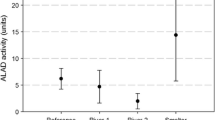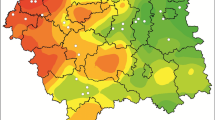Abstract
Concentrations of zinc, copper, and cadmium were determined in soil and liver, kidney, bone and stomach contents of deer mice (Peromyscus maniculatus) from two sites near an abandoned mine and one control site, on Vancouver Island, British Columbia, Canada. Soil concentrations of copper were significantly elevated at the mine and off site vs the reference site. In contrast, there was no difference in soil cadmium and zinc concentrations between the mine and reference site. Concentrations of copper, cadmium and zinc in livers of mice from the mine site were significantly elevated relative to the reference and off site locations. Cadmium kidney concentrations tended to be greater in mice from the mine versus the off site and reference site. No differences in bone cadmium, copper and zinc and, kidney copper and zinc concentrations were noted among mice from the three locations. Diet of mice from mine and off sites contained significantly greater copper concentrations than the reference population; no differences in cadmium or zinc diet concentrations in mice from the three sites were noted. Comparison of ratios of metal concentrations in diet:soil and concentrations in liver:soil suggest that for zinc and copper, soil and diet are of equal importance as a source of metal contamination to these mice. In contrast, cadmium diet:soil and cadmium liver:soil ratios were much greater than one indicative of bioconcentration of cadmium from soil to diet and from soil to liver. For assessing routes of metal exposure, in this case for deer mice inhabiting an abandoned mine site, for copper and zinc, soil will most likely be indicative of exposure conditions. In contrast, concentrations of cadmium in diet will be more representative of amounts that the animal is potentially ingesting. Of further importance is that relative to reference sites, mice inhabiting an abandoned copper mine site have significantly elevated tissue levels of copper. This is turn will provide a route of metal exposure to canivorous birds such as owls and hawks. The toxicological significance of this exposure to birds of prey has yet to be assessed adequately.
Similar content being viewed by others
References
Anthony RG, Kolzlowski R (1982) Heavy metals in tissues of small mammals inhabiting waste water-irrigated habitats. J Environ Qual 11:20–22
Bates M (1993) Copper in them Thar Hills!. In: The Bay Buzzer; The Cowichan Lake Business Community. Issue #9. October 1993
Bremner I, Marshall RB (1974) Hepatic copper- and zinc-binding proteins in ruminants. Br J Nutr 32:293–300
Brummer GW (1986) Heavy metal species, mobility and availability in soils. In: The importance of chemical “speciation” in environmental processes. Bernhard M, Brinckman FE, Sadler PJ (eds) pp 169–192/ Dahlem Konferenzen 1986. Springer-Verlag Berlin
CCME (1991) Canadian Council of Ministers of the Environment. Interim Canadian Environmental Quality Criteria for Contaminated Sites. Report CCME EPC-CS34. Sept. 1991. 20 pp
Cherian MG, Goyer RA (1978) Metallothioneins and their role in the metabolism and toxicity of metals. A mini-review. Life Sci 23:1–10
Elsenhans B, Schmole G, Kolb K, Stokes J, Forth W (1987) Metalmetal interactions among dietary toxic and essential trace metals in the rat. Ecotoxicol Environ Saf 14:275–287
Environment Canada (1993) State of the environment report for British Columbia. Ministry of Environment, Lands and Parks. 127 pp
Folkeson L, Nyholm HEI, Tyler G (1990) Influence of acidity and other soil properties on metal concentrations in forest plants and animals. Science Total Environ 96:211–233
Hunter BA, Johnson MS, Thompson DJ (1987) Ecotoxicology of copper and cadmium in a contaminated grassland ecosystem. III. Small mammals. J Appl Ecol 24L:601–604
Jackson N (1977) The effect of dietary copper sulphate on laying performance, nutrient intake and tissue copper and iron levels of the mature, laying domestic fowl. Br J Nutr 38:93–100
Johnson MS, Roberts MD, Hutton M Inskip MJ (1978) Distribution of lead, zinc and cadmium in small mammals from polluted environments. Oikos 30:153–159
Linzey AV, Grant DM (1994) Characteristics of a White-Footed Mouse (Peromyscus leucopus) Population inhabiting a polychlorinated biphenyl contaminated site. Arch Environ Contam Toxicol 27:521–526
Ma W, Faber J (1991) Hazardous exposure of ground-living small mammals to cadmium and lead in contaminated terrestrial ecosystems. Arch Environ Contam Toxicol 20:266–270
Pascoe GA, Blanchet RJ, Liner G (1994) Bioavailability of metals and arsenic to small mammals at a mining waste-contaminated wetland. Arch Environ Contam Toxicol 27:44–50
Phendler R (1980) Assessment Report #8896. For: Corrie Copper Ltd. 1980
SAS Institute Inc (1988) SAS/STAT User's guide, Release 6.03 Edition. Cary, NS: SAS Institute Inc. 1988. 1028 pp
Scheuhammer AM (1987) The chronic toxicity of aluminium, cadmium, mercury and lead in birds: A review. Environ Pollut 46:263–295
Shukla GS, Chandra SV (1987) Concurrent exposure to lead, manganese and cadmium and their distribution to various brain regions, liver, kidney and testis of growing rats. Arch Environ Contam Toxicol 16:303–310
Sokal RR, Rohlf FG (1990) Biometry, second edition. W. H. Freeman, NY, 859 pp
Stickle LF (1968) Home range and travels. In: King, JA (ed) Biology of Peromyscus (Rodentia). The American Society of Mammalogist. Stillwater, OK. 373 pp
Venugopal B, Luckey TD (1978) Metal Toxicity in Mammals-2: Chemical Toxicity of Metals and Metalloids. Plenum Press, NY
Wesenberg GBR (1983) Effect of acute exposure to cadmium on zinc, copper and lead contents of hard and soft tissues of rats. Inter. J Environ Studies. 20:255–263
Whitaker JO (1980) The Audobon Society Field Guide to North American Mammals. Alfred A. Knopf, NY
Author information
Authors and Affiliations
Rights and permissions
About this article
Cite this article
Laurinolli, M., Bendell-Young, L.I. Copper, zinc, and cadmium concentrations in Peromyscus maniculatus sampled near an abandoned copper mine. Arch. Environ. Contam. Toxicol. 30, 481–486 (1996). https://doi.org/10.1007/BF00213399
Received:
Revised:
Issue Date:
DOI: https://doi.org/10.1007/BF00213399




